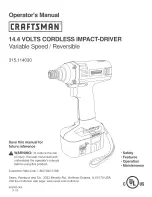
7
FIG. 3
B
Switch (Fig. 3)
FIG. 4
D
C
Pressing the bottom part of the rocker switch
(B) runs the tool in forward (right-hand
thread) direction. Pressing the top of the
switch reverses motor direction. This allows
“rocking” fasteners to break them loose.
Anvil With Detent Pin (Fig. 4)
Place the switch in the locked off (center)
position or remove battery pack before
changing accessories.
To install a socket on the anvil,
align the hole in the side of the socket with the
detent pin (C) on the anvil (D). Press the socket on until the detent pin engages in the
hole. Depression of detent pin may be necessary to aid installation of socket.
CAUTION:
Use only impact sockets. Non-impact sockets may break and cause a
hazardous condition. Inspect sockets prior to use to ensure that it contains no cracks.
To remove a socket,
depress the detent pin through the hole, using a small pointed
object, and pull the socket off.
Usage
CAUTION:
Ensure fastener and/or system will withstand the level of torque generat-
ed by the tool. Excessive torque may cause breakage and possible personal injury.
1. Place the socket on the fastener head. Keep the tool pointed straight at the fastener.
2. Press rocker switch to start operation. Always check torque with a torque wrench,
as the fastening torque is affected by many factors including the following:
•
Voltage:
Low voltage, due to a nearly discharged battery, will reduce fastening
torque.
•
Socket size:
Failure to use the correct socket size will cause a reduction in
fastening torque.
•
Bolt Size:
Larger bolt diameters generally require higher fastening torque.
Fastening torque will also vary according to length, grade, and torque coef-
ficient.
•
Bolt:
Ensure that all threads are free of rust and other debris to allow proper
fastening torque
•
Material:
The type of material and surface finish of the material will affect
fastening torque.
•
Fastening Time:
Longer fastening time results in increased fastening torque.
Using a longer fastening time than recommended could cause the fasteners to
be overstressed, stripped or damaged.
MAINTENANCE
Cleaning
WARNING:
Blow dirt and dust out of all air vents with clean, dry air at least once a
week. To minimize the risk of eye injury, always wear ANSI Z87.1 approved eye protec-
tion when performing this. Exterior plastic parts may be cleaned with a damp cloth and
mild detergent. Although these parts are highly solvent resistant,
NEVER
use solvents.
Содержание DC800-XE
Страница 1: ...DC800 XE HEAVY DUTY 36V 13 MM 1 2 CORDLESS IMPACT WRENCH INSTRUCTION MANUAL ...
Страница 2: ......
Страница 11: ...9 ...






























